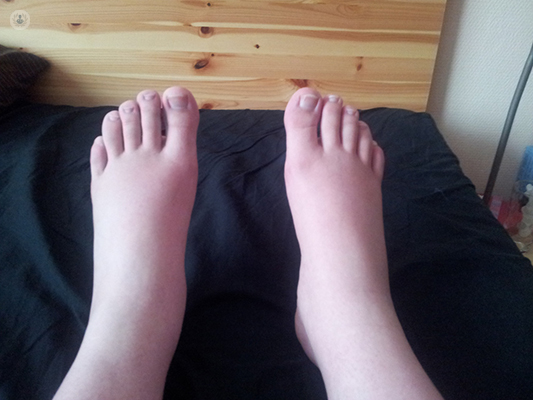Oedema
Dr Mashkur Khan - Internal medicine
Created on: 07-23-2014
Updated on: 05-20-2015
Edited by: Conor Lynch
What is oedema?
Oedema (spelt “edema” in some countries) is swelling caused by the accumulation of fluid in a particular part of the body. It is often accompanied by inflammation. Oedema usually affects the feet, ankles, and legs, although it can occur anywhere in the body. Pulmonary oedema, for example, occurs in the lungs and can cause difficulty breathing.

What are the symptoms of oedema?
There are many symptoms that patients suffering from oedema will present with. The main symptoms of oedema are:
- stretched and shiny looking skin
- swelling
- feeling of heaviness or even pain
Causes of oedema
Oedema is caused by excess fluid becoming trapped in the body’s tissues, and this is often caused by fluid leaking from the bloodstream. Therefore, many of the causes of oedema are related to things that affect the patient’s circulation.
Can oedema be prevented?
There is no way to detect oedema before its appearance, and thus, it is almost impossible to avoid or prevent it. The risk of oedema can be lowered by maintaining a healthy body weight, not eating too much salt, and avoiding sitting in the same position for too long at any one time. These measures help maintain good blood circulation and minimise the chances of other health problems.
How is oedema treated?
The best way to treat oedema is by directly treating the cause. It is very important to treat oedema because, in addition to the annoying symptoms, the skin can continue to stretch.
For swelling in the feet and ankles, the following can help:
- Lie down and raise the affected area with a pillow.
- Don’t wear tight clothes – especially shoes and socks. Wide, comfortable shoes with a soft sole and low heel are ideal.
- Do some gentle exercise – this will help improve circulation.
- Avoid sitting or standing in the same position for long periods.
- Keep your feet and ankles clean by washing, drying and moisturising them – this will help to avoid infections.
Persistent oedema may require lifestyle changes, such as adopting a low salt diet or losing weight.
What are the main risk factors?
The main risk factors or associated factors that can lead to oedema include the following:
- eating a lot of salt
- being overweight
- sitting or standing for a long time in the same position
- pregnancy
- certain medications
- injury
- liver problems
- kidney problems
- heart problems
- problems with the lymph nodes
- insect bites/stings
- infections
- a blood clot
When should I seek emergency medical attention?
If oedema doesn’t improve on its own within a few days, you should consult a doctor, particularly if it gets worse. In the following circumstances, you should ask for an urgent appointment:
- you have a high fever and/or are shivering
- the swelling is red and inflamed and feels hot to the touch
- you also have diabetes
- the swelling is particularly severe or painful
- the swelling appears very suddenly
- only one foot or ankle is swollen and you have no idea why
If you are short of breath, struggling to breathe, and/or are experiencing chest pain or tightness, call 999, as it could indicate a blood clot in the lungs.
How is oedema diagnosed?
The diagnosis of oedema can actually be quite straightforward in certain cases, with a medical history sometimes being enough for a medical professional to diagnose oedema and find its underlying cause(s). However, for some patients, a more thorough diagnostic evaluation is required, with X-rays, blood tests, urine tests, MRI scans, and ultrasound scans all being required.

Which specialist diagnoses and treats oedema?
A GP can diagnose and help treat oedema.
I have quite a severe case of oedema. How can it be treated?
For patients with severe cases of oedema, specific medication can be prescribed.
Is oedema considered to be a serious medical condition?
Oedema can, thankfully, be quite mild and can go away on its own through appropriate and effective self-care measures, such as lifestyle changes. It can, however, also be a sign of a more serious underlying condition, so prompt diagnosis and treatment is highly important.
Is oedema hereditary?
Oedema is neither hereditary nor contagious.
Can drinking water help with my oedema?
Interestingly, if you are dehydrated, your body will hold onto the fluid that it already has in the body, which leads to a build-up of fluid and an unusual accumulation of fluid.
What foods can help oedema?
Bananas are recommended, as well as any potassium-rich foods, such as tomatoes, and sweet potato.
